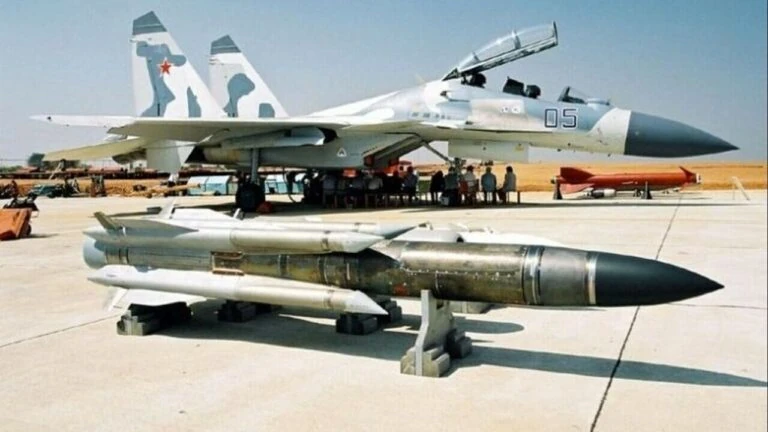Every day, aircraft from the Russian Aerospace Forces’ frontline aviation conduct combat sorties in the zone of the special military operation. The standard missile loadout of the Su-35S multirole fighter includes short-range air-to-air missiles, one or two long-range R-37M air-to-air missiles, and a pair of Kh-31PD supersonic air-to-ground strike missiles. Their main targets in this special military operation are Western air defense radars such as Patriot, NASAMS, and IRIS-T.
These Kh-31PD missiles are part of a family of advanced Russian air-launched weapons, which includes the Kh-31P anti-radar variant. The Kh-31P missile is specifically designed to destroy radar stations in long—and medium-range air defense missile systems and other sea—and ground-based radar systems. Its versatility allows it to target enemy radars for various purposes, including those part of long—and medium-range surface-to-air missile systems, airspace control, and maritime surveillance.
The evolution of this missile family is evident in its various iterations. The basic version, Kh-31P is equipped with modular passive radar homing heads PRGS-4VP (L-111), PRGS-5VP (L-112) or PRGS-6VP (L-113). Building upon this foundation, the Kh-31PD represents a modern modification of the original Kh-31P anti-radar missile, which the Soviet Air Force adopted in 1988. Technological advancements have significantly enhanced its capabilities: it now features a ramjet engine and a solid-fuel booster, enabling it to reach speeds of up to 3.3 times the speed of sound, with an increased range from 110 to 250 km. The missile’s 110 kg warhead further contributes to its destructive potential.
A key improvement in the Kh-31PD is its single wideband homing head, which replaces the different passive homing head models used in older modifications. This new model can detect enemy radars operating in the 1.2 – 11 GHz frequency range, a significant advancement that enhances its versatility and effectiveness. Since entering service in 2012, the Kh-31PD has reportedly demonstrated its capabilities in various operational scenarios.

The effectiveness of these Russian missiles, particularly the Kh-31PD, has been a topic of discussion among Russian military industrial personnel. In June 2023, Boris Obnosov, the general director of the Tactical Missiles Corporation (KTRV) and a Hero of Russia, said in an interview with RT that Russian air-launched anti-radar missiles Kh-31P outperform the missiles of the American Patriot air defense missile system (ADMS) in all combat situations.
“We have had modeling modules for a long time that allow us to compare our missiles with American ones, and we have the new Kh-31P anti-radar missile, which outperforms the American Patriot missiles in all combat situations,” he pointed out, highlighting the superiority of the Kh-31P.
These remarks were made following a report from a defense industry insider to TASS, which confirmed the exceptional performance of the Kh-31P missile during a recent military operation.
The KH-31 missile family is designed for compatibility with various MiG-29 and Su-27 variants, which extends to the Indian Air Force’s MiG-29 and Su-30MKI fighters. While it’s been reported that many of the Kh-31 missiles in the Indian service have exceeded their operational lifespan, this may not apply to the entire inventory.
India has long operated these missiles. In 1998, Kommersant reported Sergei Yakovlev, CEO of the Zvezda-Strela State Research and Production Center, saying that Russia sells the Kh-31A to three countries: India, China, and Vietnam. He was replying to a query about Boeing’s proposal to purchase the noncombat Kh-31A for target practice by the US Navy.
The exact number of Kh-31P missiles currently in Indian service remains undisclosed. However, there is evidence of more recent acquisitions. According to the Russian ArmsTrade resource, an unspecified quantity of Kh-31PDs was sold to India as recently as 2019. This information suggests that at least some portion of India’s Kh-31P stock may still be within its operational lifespan.
Given the lack of precise public information, it’s challenging to ascertain the full status of India’s KH-31P inventory. The mix of older and potentially newer missiles in service underscores the complexity of maintaining and updating military hardware over time.
Recent reports on the missile’s performance in the Ukraine conflict have apparently caught the attention of India’s Air Force. As a result, the Indian defense ministry is considering investing in a life extension program for its stockpile of Kh-31P air-launched missiles. The potential revival of interest in the Kh-31P comes at a time when India is balancing the use of imported systems with the development of indigenous defense technologies. Hence, this development is particularly interesting given that India has already conducted successful tests of its domestically produced RudraM-II anti-radar missile.
The Expression of Interest (EoI) document specifies that domestic Indian firms should maintain, including overhaul, refurbishment, and life extension, these end-of-life Kh-31P missiles.
